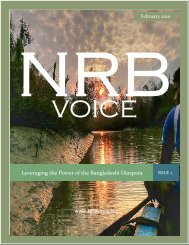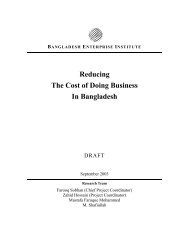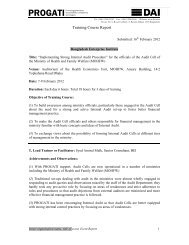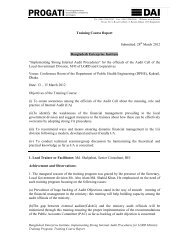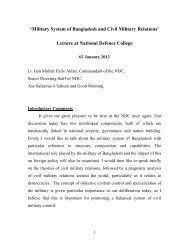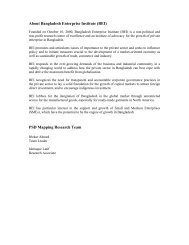Bangladesh Social Enterprise Project - Bangladesh Enterprise Institute
Bangladesh Social Enterprise Project - Bangladesh Enterprise Institute
Bangladesh Social Enterprise Project - Bangladesh Enterprise Institute
You also want an ePaper? Increase the reach of your titles
YUMPU automatically turns print PDFs into web optimized ePapers that Google loves.
multinationals), opportunities, skills and information.<br />
business skills but also in new technologies and financing mechanisms.<br />
Entrepreneurs need training in basic<br />
Donors and social investors need to become more risk tolerant. A standard rule of thumb in<br />
commercial venture capital is that the failure rate in the process of going from a business idea<br />
through to a pilot project through to a small venture through to a big business is 90% at each<br />
stage 7 – i.e. to get one big business one has to have a portfolio of 1000 ideas or 100 pilot<br />
projects. Donors have to be willing to support (with capital, training and expertise) a wide<br />
range of emerging ideas and have M&E mechanisms which tolerate a high level of failure. For<br />
such a failure rate to be affordable, donors and social entrepreneurs have to focus on<br />
developing low‐cost pilot projects which rapidly test the key assumptions of a business idea<br />
before large‐scale implementation is considered.<br />
Donors and social investors have to more tolerant of uncertainty. If they insist on wellproduced<br />
long‐term business plans in English they will simply exacerbate the problem of elite<br />
dominance of entrepreneurship. Donors and investors need to accept that initial business ideas<br />
will often be ill‐formed and highly uncertain. In particular it is often impossible to predict the<br />
long‐term potential of an idea. Donors and investors should not impose a tick‐box mentality of<br />
“ensuring” that each project will contribute to a long list of donor objectives such as social<br />
inclusion, gender mainstreaming and sustainable development – in many cases it is simply<br />
impossible to say whether these objectives will be met. Instead, donors and investors should<br />
focus on whether the pilot project offers a reasonable prospect of alleviating a specific, welldefined<br />
social problem at an acceptable cost.<br />
The design of this project initially envisaged bringing together potential entrepreneurs, big<br />
business and Government to work together to invent and develop new social enterprise<br />
concepts from scratch. In practice this proved to be too ambitious, particularly because big<br />
business and Government representatives were not willing to spend time working on the initial<br />
7 Gary Hamel, ‘Competing for the Future’.<br />
BSEP: Policy Brief<br />
Page 10



